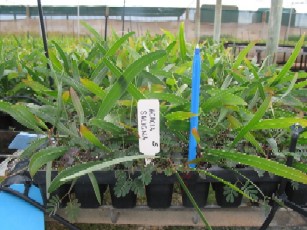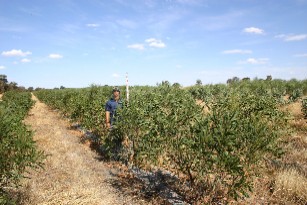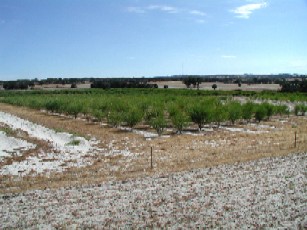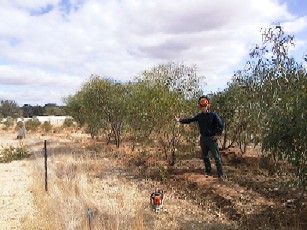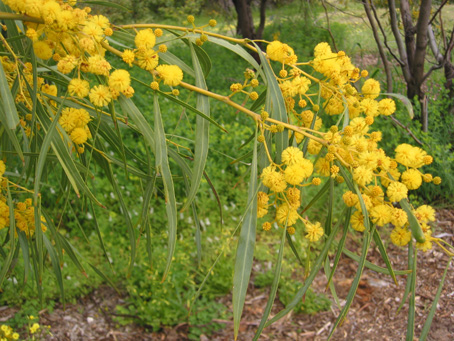
Acacia saligna ('Cyanophylla' variant): in native habitat at City Beach,
Perth, Western Australia. (Photo: B.R. Maslin)
Work currently being conducted by the Western Australian Department of Conservation and Land Management (CALM), the Cooperative Research Centre for Plant-based Management of Dryland Salinity, the Joint Venture Agroforestry Program, the Australian Commonwealth Scientific and Industrial Research Organization (CSIRO) and others, is evaluating the genetic resources of Acacia saligna (Coojong) which could become an important source of biomass production for energy, wood composites and charcoal, on farmland affected by dryland salinity. This webpage presents a brief outline of the work.
|
|
|
Acacia saligna has a long history of multipurpose use in Australia and overseas. Under cultivation this species is capable of developing into a robust woody shrub or small tree, growing on a wide range of soils and producing a good quantity of woody biomass. In the past it has been used for mine site rehabilitation, revegetation, in agroforestry, amenity plantings and as a fodder plant for stock. In some areas Coojong has become an environmental weed.
Descriptions and other information concerning A. saligna (prepared prior to the current studies being commenced) may be viewed elsewhere on WorldWideWattle. The most recent species profile of A. saligna was prepared in connection with the AcaciaSearch project but the descriptive, geographic and other information presented below updates this account. AcaciaSearch ranked Coojong the highest of the 35 Acacia species that were considered prospective for development as new woody crop plants for the agricultural regions of southern Australia.
Acacia saligna has a wide but discontinuous natural distribution that is confined to southwest Western Australia. It extends from the Murchison River southeast through the semi-arid wheatbelt region to near Esperance on the south coast. The eastern extent of its distribution is bounded approximately the 300 mm isohyet while in the west it extends into temperate forest and coastal regions. Coojong is often locally abundant in the places where it occurs. It is often found along disturbed roadverges but it is sometimes difficult to determine if these represent natural occurrences or the result of roadside revegetation programs.
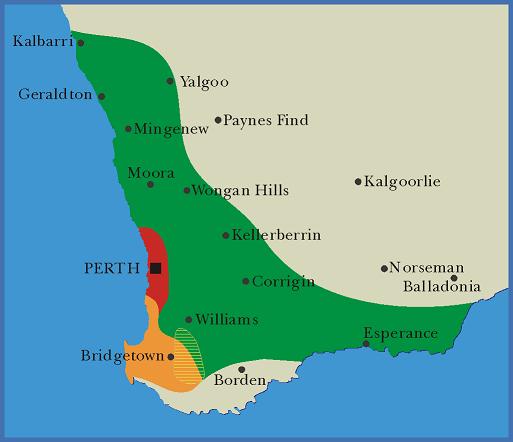
Distribution of A. saligna in its native habitat, south-west Western Australia. Discussion of the four main variants shown on this map is presented below. The variants have discontinuous distributions (although they are often common in the places where they occur), therefore, they are not as common in the landscape as this map might imply. This map updates the one presented in the AcaciaSearch report.
Coojong grows in a range of habitats but is most commonly found on depositional sites low in the topography. It prefers deep sandy soils in wet areas such as along creeks and rivers, the margins of lakes and swamps, the base of granite rocks and coastal interdune swales. Soils range from acidic to alkaline and include sands, sandy loams or sandy clays; they are sometimes moderately saline at depth.
| Variant |
Altitudinal range
|
Mean max. hottest mth
|
Mean min. coldest mth
|
Mean annual rainfall
|
|---|---|---|---|---|
| 'Typical' |
100-350 m
|
28-39°C
|
5-9°C
|
250-600 mm
|
| 'Cyanophylla' |
0-90 m
|
28-33°C
|
8-10°C
|
750-900 mm
|
| 'Tweed River' |
150-300 m
|
30-31°C
|
4-6°C
|
800-1000 mm
|
| 'Forest' |
5-300 m
|
27-30°C
|
6-8°C
|
900-1000 mm
|
Variation in Acacia saligna and implications for its domestication
(Research by Maurice McDonald, Bruce Maslin & Wayne O'Sullivan)
Coojong is perplexingly variable throughout its natural range and four main variants are currently recognised to accommodate this variation, namely, the 'Typical', 'Cyanophylla', 'Forest' and 'Tweed River' variants. These variants differ from one another by a combination of morphological, ecological and biological attributes (see Tables 1 and 2).
While no reliable, unique identifier clearly distinguishes any of the variants, work is in progress to discriminate the taxa by coding their differences into an electronic, multi-access key using the Lucid program. We have not yet determined the appropriate rank for these taxa, however, they will be formally named in due course and the Lucid key to taxa presented on this webpage.
| Variant | Habit | Bark | Juvenile phyllodes | Adult phyllodes: lustre, colour, curvature and orientation | Phyllode gland | Suckering |
|---|---|---|---|---|---|---|
| 'Typical' | Very variable but usually a shrub 2-4(5) m tall with dbh 5-10 cm, sometimes a tree to 10 m with dbh to 20 cm | Thin, hard, fissured at base of stems on oldest plants, smooth above | Linear to elliptic, to 25(-40) x 4.5 cm, green, sub-glossy to glossy | Sub-glossy to glossy; green; often straight; held at ±90° to stem on terminal branchlets | 0-12 above pulvinus | Nil to low |
| 'Cyanophylla' | Shrub or tree 3-10 m tall, dbh 20-40 cm | Thin, fissured at base of stems, smooth above | Linear, up to 40 x 4 cm, dull, grey-green | Dull to sub-glossy; sub-glaucous to grey-green; often slightly curved; held at ±45° to stem on terminal branchlets | 0-5 mm above pulvinus | Low to moderate |
| 'Tweed River' | Tree 3-10 m tall, dbh to 35 cm | Thick, friable, with a platy fracture | Broadly elliptic, to 34 x 10 cm, undulate dull, pruinose, blue green | Dull; glaucous and often pruinose; straight; held at ±45° to stem on terminal branchlets | 0-5 mm above pulvinus | Aggressive |
| 'Forest' | Shrub or tree 3-8 (-10) m tall, dbh 10-20 cm | Thin, with a platy (rectangular) fracture at base of stems, sub-smooth with annular rings above | Linear, to 38 x 3.5 cm, dull, green | Dull to sub-glossy; sub-glaucous to green; straight to slightly curved; held at ±45° to stem on terminal branchlets | 0-5 mm above pulvinus | Aggressive to very aggressive |
Understanding and quantifying variation for some of the morphological characters is especially complicated because attributes normally differ depending upon the biological age of the plant (i.e. juvenile, adolescent or adult): this applies particularly to bark and phyllode characters. Variation in important biological attributes such as growth form, biomass production, suckering propensity and fodder value, have particular relevance to the utilisation of the species.
All variants of Coojong are capable of producing a good growth form but all are highly variable for this trait. For example, the 'Forest' variant very often has crooked stems and branches and, along with the 'Typical' variant in particular may become very spindly under certain conditions. A similar range of variation is found among the variants for wood biomass production and wood density (range 470-735 kg/m3). Additionally, all variants exhibit considerable provenance variation survival and growth rates.
'Typical' variant
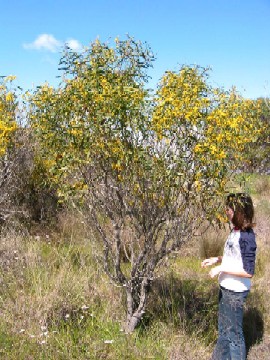 This
is the most widespread and most variable of the four variants. It occurs
in inland regions (predominantly the wheatbelt) where it extends from
the Murchison River in the north (with a few outliers in the arid zone
between north of Yalgoo) to east of Esperance on the south coast. Esperance
is the type locality of the species, having been collected there by
Labillardiere in 1792; the type specimen is housed in the Florence herbarium,
Italy. The eastern extent of its distribution is bounded approximately
the 300 mm isohyet while in the west and south it abuts the range of
the 'Cyanophylla' and 'Forest' variants where the taxa are occasionally
sympatric or parapatric.
This
is the most widespread and most variable of the four variants. It occurs
in inland regions (predominantly the wheatbelt) where it extends from
the Murchison River in the north (with a few outliers in the arid zone
between north of Yalgoo) to east of Esperance on the south coast. Esperance
is the type locality of the species, having been collected there by
Labillardiere in 1792; the type specimen is housed in the Florence herbarium,
Italy. The eastern extent of its distribution is bounded approximately
the 300 mm isohyet while in the west and south it abuts the range of
the 'Cyanophylla' and 'Forest' variants where the taxa are occasionally
sympatric or parapatric.
The 'Typical' variant grows mainly along seasonally dry watercourses and around the base of granite rocks but also occurs on coastal sand dunes around Esperance. In places it extends to saline drainage systems such as the human-induced salt-affected, upper catchment of the Avon River (e.g. east of Brookton).
The 'typical' variant is commonly a shrub 2-4 (-5) m tall with stout, straight to sub-straight main stems about 5-10 cm dbh, however, around granite rocks it may reach 10 m tall with stems to 20 cm dbh. In the field this variant usually has pendulous terminal foliage, which can help distinguish it from the other variants. Some populations on the fringe of its distribution are represented by weakly developed, spindly, pendulous plants, which have negligible potential for biomass production. The bark on the 'Typical' variant is commonly smooth (but longitudinally fissured towards base of main stems on oldest plants) and the phyllodes bright green. This variant normally reproduces by seed (suckering individuals do occur but not at a high frequency).
As currently delineated, variation in the 'Typical' variant includes a northern form that occurs along the Arrowsmith, Arrino, Irwin and Murchison River drainage systems. These populations have more glossy foliage relative to other populations and often comprise smaller plants, rarely taller than 2 m (some are occasionally prostrate). Study is in progress to assess the status of this form.
View images of the 'Typical' variant.
'Cyanophylla' variant
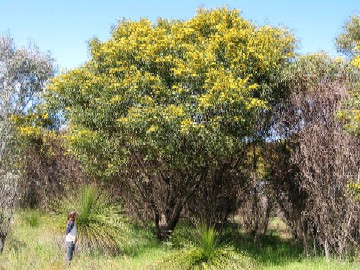 This
appears to be the most geographically restricted of the A. saligna
variants even though it is probably the on most widely distributed outside
its natural range on account of being commonly utilised for a range
of purposes. Natural occurrences of the 'Cyanophylla' variant are in
the vicinity of Perth where it occurs on the Swan Coastal Plain from
near Yanchep to Mandurah, a distance of around 150 km. Because this
variant has so commonly been used as an ornamental, in roadside and
on-farm plantings, and in various revegetation programs, it is somewhat
difficult to be certain of its true natural distribution (especially
on the Swan Coastal Plain south of Mandurah). It is this variant to
which the name A. cyanophylla was originally applied, the type
specimen having been collected by Captain James Mangles (probably from
around Fremantle) in the 1830's and now housed at the herbarium in Cambridge,
England. The 'Cyanophylla' variant is typically found on deep sandy
soil, often near swamps.
This
appears to be the most geographically restricted of the A. saligna
variants even though it is probably the on most widely distributed outside
its natural range on account of being commonly utilised for a range
of purposes. Natural occurrences of the 'Cyanophylla' variant are in
the vicinity of Perth where it occurs on the Swan Coastal Plain from
near Yanchep to Mandurah, a distance of around 150 km. Because this
variant has so commonly been used as an ornamental, in roadside and
on-farm plantings, and in various revegetation programs, it is somewhat
difficult to be certain of its true natural distribution (especially
on the Swan Coastal Plain south of Mandurah). It is this variant to
which the name A. cyanophylla was originally applied, the type
specimen having been collected by Captain James Mangles (probably from
around Fremantle) in the 1830's and now housed at the herbarium in Cambridge,
England. The 'Cyanophylla' variant is typically found on deep sandy
soil, often near swamps.
This variant grows as a tall erect shrub or tree 3-10 m tall, it is either single-stemmed or has a short main stem which branches near the base, the stems are robust, straight to sub-straight and reach about 20-40 cm dbh. In the field, mature plants of this variant have sub-glaucous or grey-green foliage comprised of relatively narrow and often gently recurved phyllodes which help distinguish it from the other variants. The crown is dense and bushy and the bark is smooth but longitudinally fissured towards the base of main stems on oldest plants. This variant produces root suckers but seemingly not as aggressively so as the 'Tweed River' and 'Forest' variants; it coppices well.
View images of the 'Cyanophylla' variant.
'Forest' variant
|
The 'Forest' variant occurs on a variety of soils (sand to clay) and is most commonly found along watercourses and other wet sites, it also extends to coastal sand dunes in places. The 'Forest' variant does not grow on laterite soils even though its range occurs in an area dominated by laterite. This variant grows as a tall shrub or tree 3-8 (-10) m tall (spindly forms occur in places), it is single-stemmed or has a few main stems from the base, the stems are commonly sub-straight to rather crooked (although sometimes straight) and reach 10-20 cm dbh. In the field this variant is most readily distinguished from the 'Typical' and 'Cyanophylla' variants by its bark, which is friable (crumbly) and breaks with a rectangular fracture (a similar bark is found in the 'Tweed River' variant). It also has an aggressive suckering habit often forming dense, localised, clonal clumps, a trait not seen in the 'Typical' variant and is not as common in the 'Cyanophylla' variant. |
View images of the 'Forest' variant.
'Tweed River' variant
|
The 'Tweed River' variant grows to a tree 3-10 m tall with either a single-stem or with a few main stems from the base, the stems have an erect aspect, are straight to rather crooked and reach 35 cm dbh on the oldest plants. The bark is similar to that found on the 'Forest' variant (although it is thicker). In the field, mature plants of the 'Tweed River' variant are most readily distinguished from the other variants by their usually white pruinose branchlets and their glaucous (and often pruinose), relatively short, straight phyllodes. Also, the juvenile plants have large, undulate, pruinose, elliptic phyllodes which serve to characterize the 'Tweed River' variant. It suckers aggressively, a trait it shares with the 'Forest' variant with which it is often sympatric. |
View images of the 'Tweed River' variant.
Flowering time differences among variants
In addition to the morphological differences outlined above there appears to be differences in peak flowering times among variants (Table 3) but precise knowledge of phenology is currently sketchy. Current evidence suggests that under natural conditions pollen movement, and hence gene flow, may be limited in a number of key areas where variants occur in close geographic proximity. Details concerning flowering times are to be confirmed by further field assessment.
| Variant | Peak Flowering |
|---|---|
| 'Typical' | mid October |
| 'Cyanophylla' | August - September |
| 'Tweed River' | late September |
| 'Forest' | mid October |
Implications and Outcomes
The taxonomic work on variation in Coojong will have a direct bearing on its utilisation potential. Our aim is to develop a better understanding of these patterns of variation to provide a sounder basis for the effective management and utilisation of the species that will be relevant to all growers concerned with its domestication. It is expected that this work will facilitate a more judicious use of the species for large volume wood production and numerous other purposes. Outcomes will include a formal taxonomic paper delineating the variants and possibly an allozyme study documenting patterns of genetic variation and phylogenetic relationships (a genetic study of variation in A. saligna using RFLP markers has already been completed-see below) and a Lucid key to the variants.
Updated summaries of activities will be presented on this webpage as work progresses.
Analysis of genetic variation and fodder potential in Acacia saligna
(Research by Nic George and Margaret Byrne)
As part of work to manage dryland salinity there is interest in the potential of using A. saligna as perennial livestock forage in the wheat-sheep belt of southern Australia. Despite its wide spread utilization as a forage crop preliminary research has concluded that A. saligna is inadequate as a sole source of feed for ruminants, due mainly to low dry-matter digestibility and high tannin levels. The high morphological variability and low feed quality of A. saligna are serious impediments to the utilization of the species. For this reason, a project was undertaken to examine the level and pattern of genetic variation in A. saligna and its correlation with the morphological variation, and also to investigate variation in feed quality within the species.
Genetic analysis of A. saligna revealed considerable genetic variation that showed structuring into three genetically distinct groups. Two of the groups corresponded to the 'Typical' or 'Forest' variants while the third group encompassed both the 'Cyanophylla' and 'Tweed River' variants which were not genetically different. The study therefore suggests the presence of at least three genetic lineages within A. saligna that may represent different taxa and indicates that a taxonomic revision of the species is required; it also highlighted the need to re-examine the differences between the 'Cyanophylla' and 'Tweed River' variants. The results of this study are currently being prepared for publication.
The analysis of the feed quality showed that on average A. saligna has low quality fodder in comparison to other common forage species, due to low digestibility and moderate to high tannin levels. The values are comparable to results from other studies of A. saligna and are similar to other species of phyllodenous Acacia. However, the study also found there is considerable variation in the feed quality of the populations that were sampled. The variation in feed quality was also found to be strongly associated with the genetic groups and only weakly associated with climate and soil types. Digestibility and protein content are crucial indicators of feed quality and populations of the 'Cyanophylla' and 'Tweed River' variants were found to have higher digestibility and protein content than the populations of the 'Typical' or 'Forest' variants.
The general conclusion from the work is that the high levels of genetic variation between and within each variant of A. saligna suggests there is a large genetic base that can be used for breeding improved cultivars of A. saligna. Important aspects of feed quality appear to be under some genetic control so the feed quality of A. saligna could potentially be improved via selection of superior individuals with a focus on the 'Cyanophylla' variant. However, further work to develop A. saligna as a crop will require trials using material of known provenance to test the performance of the genetic entities in the wheat-sheep belt and to determine the effect of different environmental conditions on feed quality.
An Assessment of Genetic Risk to Natural Biodiversity from Agroforestry Revegetation
(Research by Melissa Millar, Margaret Byrne, Ian Nuberg and Margaret Sedgley)
Planted species can pose risks to biodiversity through genetic contamination and weed invasion. This project is investigating weed and genetic risk aspects of the utilization of A. saligna for agroforestry. Acacia saligna has been identified as having weed risk as it has become naturalized in areas of South Australia and Victoria, although it does not show evidence of invasiveness in its natural range in Western Australia. The project will investigate some aspects of the reproductive system that may be implicated in the species weediness in areas where it has become naturalised.
A previous study has identified significant genetic differentiation between the variants of A. saligna that means planting of one variant within the natural range of another variant could lead to contamination of the genetic integrity of the natural populations. This depends on the level of gene flow between the variants and the project is investigating pollen dispersal and cross compatibility between variants, particularly the 'Cyanophylla' and 'Typical' variants.
The outcomes of this project are focused on the maintenance of biodiversity in natural populations of Acacia saligna in Western Australia and knowledge of the species invasiveness throughout Australia.
The project is part of the Salinity CRC's 'Biodiversity' program, 'Enhancing Biodiversity in Salinising Landscapes'. Melissa Millar is a PhD student at the University of Adelaide, working closely with Margaret Byrne at CALM.
Western Australian field trials involving Acacia saligna
(Research by Dan Huxtable, John Bartle, Graeme Olsen and Wayne O'Sullivan).
A. saligna has been widely used in farmland revegetation programs in the south west of Western Australia since the 1980's. It prefers deep, sandy soils but adapts well to range of soil types. The species is normally established by transplanting 6-month-old nursery grown seedlings into the field during winter. Seedlings are grown in multiple cell containers with a cell size of 40-90 cubic centimeters. Acacia saligna has also been successfully established using bare rooted seedlings or by direct sowing in the field. It grows rapidly and is particularly useful for stabilizing eroding sites. Under cultivation, it tends to have a short lifespan: typically less than 10 years and in some instances less than 5 years.
|
|
|
There is interest in developing A saligna as a crop plant for wood and biomass production. CALM began serious investigation of the commercial potential of this species in the late 1990's, through the Commonwealth Natural Heritage Trust funded Search project (NHT project number 973849). The Search project sought to identify native woody plants suitable for development into commercially viable large-scale crops for low annual rainfall areas (less than 600mm). Acacia saligna was one of about 20 native species that showed good potential to provide feedstock for processed wood products and renewable energy industries.
Farm grown A. saligna in Western Australia has the following characteristics:
- Wood basic density 470-730 kg/m3.
- Whole plant moisture content 40-50%
- Wood moisture content 35-50%.
- Phyllode moisture content 62-68%.
The Search project established a number of mixed species field trials between 2000 and 2004, which included several provenances A saligna. In addition, a number of spacing trials (see figure below) using A. saligna were established in 2003 with the objective of measuring biomass production and water use. CALM is actively monitoring these trials and some destructive yield assessments have been made. Initial measurements suggest that for the 300-600mm rainfall zone of south west Western Australia, above ground yields of 20-50 green tonnes/hectare are attainable over a 4 year rotation in block plantings. Above ground yields of greater than 100 green tonnes/ha could be obtained over a 4 year rotation in belt plantings (2 row belts) on favourable sites.
|
|
|
The scope for developing allometric relationships that allow rapid, non-destructive yield estimation is being investigated. Data from several sites indicates that stem basal area correlates well with fresh above ground biomass. This observation agrees with studies from other parts of the world (Laamouri et al. 2002; van Laar & Theron 2004).
Further work is required to develop low rainfall planting designs that maximise yields and integrate with existing annual crop and pasture farming systems. This could involve active capture of surface and subsurface water flows. Selective breeding offers the potential to improve growth rates and feedstock characteristics. There is scope to reduce harvesting costs by developing continuous feed harvesting equipment. The possibility of generating co-products, such as fodder or chemical extractives, is being explored to improve the economic competitiveness of A. saligna as a crop plant.
References:
Laamouri, A., Chtourou, A and Ben Salem, H. (2002) "Prédiction de la biomasse aérienne d'Acacia cyanophylla Lindl. (Syn. A. saligna (Labill.) H. Wendl) à partir de mensurations dimensionnelles" Ann. For. Sci. 59 335-340
Van Laar, A. and Theron, J.M. (2004) "Equations for predicting the biomass of Acacia cyclops and Acacia saligna in the western and eastern Cape regions of South Africa - Part 1: Tree level models" South African Forestry Journal, 201, July 2004
Some useful Web links to A. saligna
GLOBAL DISTRIBUTION
ILDIS (International Legume Database Database and Information Service)
DESCRIPTIONS AND USES
FODDER
A.A. Degen et al. "Acacia saligna as a fodder tree for desert livestock and the interaction of its tannins with fibre fractions." (Journal of the Science of Food and Agriculture, Band 68, Heft 1, 1995, S. 65-71.)
T.H. Johnson "An evaluation of Acacia saligna as a maintenance forage for sheep" (Proceedings of the 8th Australian Agronomy Conference, Toowoomba, 1996)
D. Howard et al. "The value of Acacia saligna as a source of food for sheep." (Conservation Science Western Australia 4(3): 135-138, 2002)
G.L. Krebs et al. "The value of Acacia saligna as a source of fodder for ruminants" (Executive summary of RIRDC Publication No 02/165, 2003)
WEEDINESS
Agricultural Research Council of South Africa (ARC):
SOIL NUTRIENTS
J. Lehmann et al. "Nutrient interactions of alley cropped Sorghum bicolor and Acacia saligna in a runoff irrigation system in Northern Kenya." (Plant and Soil 210: 249-262, 1999)
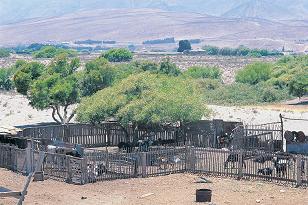
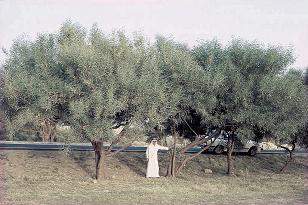
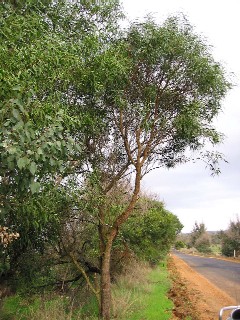 The 'Forest' variant is distributed in the mesic Jarrah-Marri
forest region south of Perth. It extends from near Manjimup north
to Boyup Brook and the Preston River near Donnybrook, then westward
to the coastal dune system between Augusta and Bunbury; it is
also found on the Swan Coastal Plain then north of Bunbury where
it almost intersects with the 'Cyanophylla' variant south of Mandurah.
The 'Tweed River' variant is not uncommonly sympatric with the
'Forest' variant.
The 'Forest' variant is distributed in the mesic Jarrah-Marri
forest region south of Perth. It extends from near Manjimup north
to Boyup Brook and the Preston River near Donnybrook, then westward
to the coastal dune system between Augusta and Bunbury; it is
also found on the Swan Coastal Plain then north of Bunbury where
it almost intersects with the 'Cyanophylla' variant south of Mandurah.
The 'Tweed River' variant is not uncommonly sympatric with the
'Forest' variant.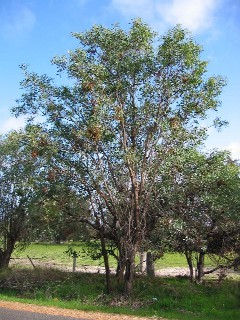 This variant has a scattered distribution in an area approximately
bounded by Bridgetown, Manjimup, Kojonup and Collie.
This variant has a scattered distribution in an area approximately
bounded by Bridgetown, Manjimup, Kojonup and Collie.